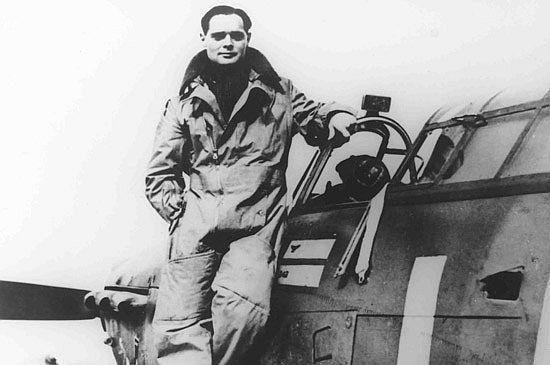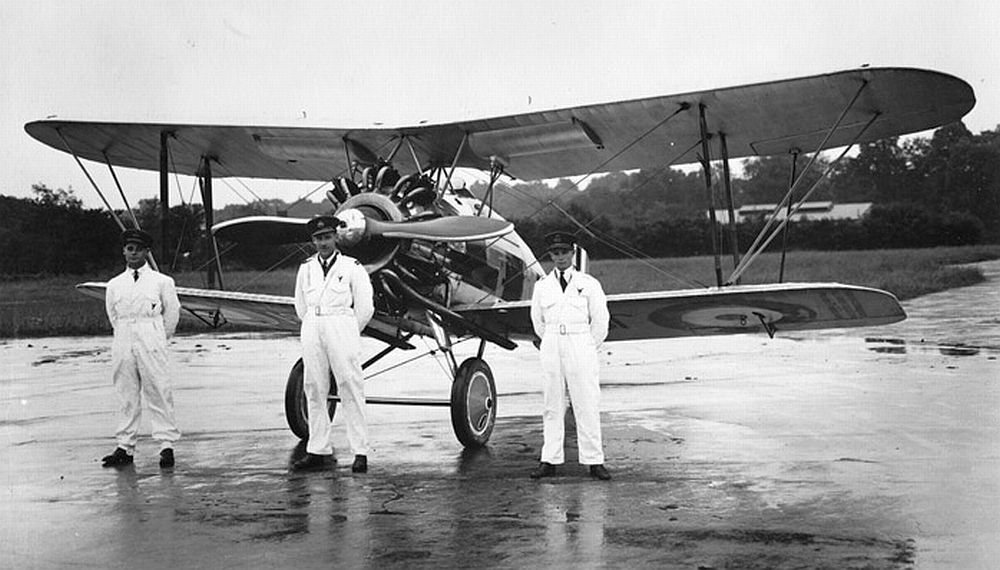P
PoorOldSpike
Guest

Bader won a scholarship to Cranwell, graduating in 1930. He was a keen sportsman, representing the College at Rugby, Shooting, Hockey, Athletics, Boxing and Cricket - the College Journal reported a boxing match in which "Bader in his usual 'no-time-to-spare' manner went straight at his opponent and knocked him out with two very hard rights. He took about the same time as he did last year, and is a very dangerous man to meet."
From Cranwell Bader was posted to No.23 Squadron at Kenley, flying the Gloster Gamecock. He developed a talent for aerobatics and in 1931 performed in the RAF Display at Hendon.
Bader (left) before his accident

On 14 December, shortly after the Squadron's Gamecocks had been replaced by Bristol Bulldogs, Bader crashed at Woodley aerodrome, near Reading and was seriously injured. His right leg was amputated that day, and the left a few days later.
Within six months of the accident Bader had not only learned to walk unaided on artificial legs, but was determined to fly again. Although he was able to demonstrate that he could meet the RAF's demanding requirements, a medical board ruled that he could not continue as an RAF pilot. He left the RAF in 1933 and joined the aviation department of the Asiatic Petroleum Company, soon to become part of Shell.
In the summer of 1939 Bader, aware that war was inevitable, set out to rejoin the RAF.
He easily passed tests at the Central Flying School and then undertook a refresher course before joining No.19 Squadron in February 1940 at Duxford. Here he first flew the Supermarine Spitfire, undertaking convoy patrols but without seeing action. A posting to No. 222 Squadron, also at Duxford, brought action over Dunkirk in June 1940 and on the 24th he was promoted to squadron leader and given command of No. 242 Squadron at Coltishall consisting mostly of Canadians.
The squadron had suffered heavy casualties in the Battle of France and morale was low. Bader immediately transformed his unit, concentrating on improving his pilots' flying, teamwork and confidence. The Squadron's first major success came on 30 August when they claimed 12 enemy aircraft, of which Bader shot down two. As the Battle of Britain progressed Bader led larger formations, with 242 and other squadrons forming the Duxford Wing. By the end of 1940 Bader's squadron had shot down 67 enemy aircraft, for the loss of only five pilots killed in action.
In March 1941 Bader left 242 and was promoted to lead the fighter wing based at Tangmere. The RAF now mounted daylight raids on occupied Europe, with bombers escorted by large numbers of fighters, to draw German fighters up to be attacked. Bader's score rose to 20 confirmed as destroyed (plus two shared) but on 8 August he was forced to bale out of his Spitfire. He recorded in his log book "Shot down 1 Me 109F & collided with another. POW" but opinions vary, and a more recent investigation suggests that he may have been the victim of friendly fire.
As Bader descended under his parachute, he noticed "My right leg was no longer with me... the leather belt which attached it to my body had broken under the strain, and the leg, the Spitfire, and I had all parted company." He was knocked unconscious on landing and woke to find two German soldiers removing his parachute harness.
Bader was taken to hospital in St Omer. His missing right leg was recovered from the wrecked Spitfire, and as soon as it had been repaired, he made his first attempt to escape. A rope made of bed sheets enabled him to climb down from a window, but he was soon recaptured and sent to Oflag VIB at Warburg. By that time the RAF had dropped a replacement leg by parachute, and Bader had determined to be "a plain, bloody nuisance to the Germans".
After three months in Stalag Luft III, Bader was moved to Stalag Luft VIIIB at Lamsdorf, from which he made another attempt to escape. He and four others joined a working party outside the camp, intending to make their way towards the Polish border. The alarm was raised when a Luftwaffe officer called at Lamsdorf to visit Bader and he was found to be missing; he was arrested and returned to Lamsdorf. A few days later Bader was transferred to Colditz Castle - Oflag IVC. With typical boldness, he told the Germans that he expected "to travel first class and be accompanied by a batman and an officer of equal rank." Colditz was thought to be escape-proof, and Bader remained there - making life difficult for his captors - until the camp was liberated on 15 April 1945.
